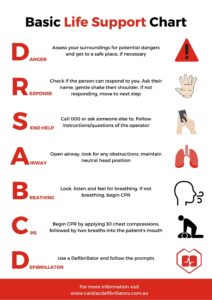DRSABCD
The DRSABCD Action Plan is a vital guide to treating a patient in a life-threatening condition. It is an action plan used extensively by St John Ambulance DRSABCD, Surf Life Saving and by many schools, university, sporting clubs, corporate office and on-site workplaces.
The action plan is extensively taught as part of Surf Life Saving Advanced Resuscitation program because incidents such as downings can cause cardiac arrest. There are estimates of over 30,000 incidents of cardiac arrests per year in Australia. It is calculated that every minute of delay will reduce the chances of survival by 10%. Essentially there is only a 10-minute window to deal with the incident. Receiving the proper training, practice and being fully prepared is essential given the short time frame.
Defibrillator Training for DRSABCD
Cardiac Defibrillators offers defibrillation training units, so participants of advanced resuscitation techniques can receive end-to-end training of the DRSABCD Action plan. It is perfectly safe to use since the unit does not provide defibrillation therapy, so it is perfect for hands-on training for the defibrillator section of the DRSABCD action program. The defibrillator trainer unit simulates different heart rhythms and gives students the opportunity to apply defibrillation pads, practice AED use, and perform CPR compression on a manikin. The clear, instructive voice and metronome guide the user through the rescue scenario. Reusable training pads enable instructors to provide training for adult and paediatric rescues.
Other Defibrillator Training Resources
We have a range of training resources for our defibrillators. View all our resources here. You can download our DRSABCD infographic to hang on the wall or place in the emergency response manual at work.
DRSABCD is an acronym/mnemonic taught on first aid courses to help you have an action plan on how to respond in a medical emergency. It >stands for Danger, Response, Send for help, Airway, Breathing, Cardiopulmonary resuscitation (CPR) and Defibrillation. If you haven’t already, make sure you do a CPR course – it could mean the vital difference between life and death. Knowing how to respond to the DRSABCD way means you can help keep a person breathing, reduce their pain or help them survive until an ambulance arrives.
Danger: If you find yourself in an emergency situation, you need to ascertain how dangerous it is to you, any bystanders and the injured/ ill person before you try to help. Do not put yourself in harm’s way when going to the assistance of another person.
Response: Check to see if the person is conscious. Do they respond when you talk to them, touch their hands or squeeze their shoulder? Communicate by talking to them loudly and gently shake their shoulders (not vigorously). If you do not get a response, the person is unconscious.
Send for help: If you realise that the situation calls for emergency services, your first action should be to send/shout/summon for help. In Australia, the number for all emergency services is triple zero. Dial 000 and answer the questions asked by the operator. Bystanders should leave a clear path/ space around the patient so that emergency services can find their way quickly.
Airway: Can the person breathe? Is the person’s airway clear? An unconscious patient is at risk of airway obstruction due to the tongue falling back. Perform a head tilt-chin lift to open their airway, this can be achieved by opening their mouth and having a look inside. If the person’s mouth is clear, tilt their head gently back (by lifting their chin) and check for breathing. If the person’s mouth is not clear, place the person on their side, open their mouth and clear any obstructions, then tilt the head back and check for breathing.
Breathing: Check for breathing by looking for chest movements (up and down). Listen by putting your ear near to their mouth and nose. Feel for breathing by putting your hand on the lower part of their chest. If the person is unconscious but breathing, turn them onto their side, carefully ensuring that you keep their head, neck, and spine in alignment. Monitor their breathing until you hand over to the ambulance officers.
CPR (cardiopulmonary resuscitation): If the person is unconscious and not breathing, make sure they are flat on their back and then place the heel of one hand in the centre of the person’s chest and your other hand on top. Press down firmly, compressing to one-third of the person’s chest depth. Do this 30 times. Give two breaths. To get the breath in, tilt their head back gently by lifting their chin. Pinch their nostrils closed, place your open mouth firmly over the person’s open mouth and blow firmly into their mouth. Keep going with the 30 compressions and two breaths at the speed of approximately five repeats in two minutes until you hand over to the arriving ambulance officers or another trained person, or until the person you are resuscitating responds. The method for CPR for children under eight years old is similar.
Defibrillator: For an unconscious person who is not breathing, apply an automated external defibrillator (AED), if one is available. Many public places, clubs, and organisations have one, so ask for it. An AED is a machine that delivers an electrical shock to cancel any irregular heartbeat (arrhythmia)and get the normal heartbeat to re-establish itself. Follow the instructions and voice prompts. If the person responds to defibrillation, turn them onto their side and tilt their head to maintain their airway. If the patient is a child, make sure the AED is suitable to use on a minor.





